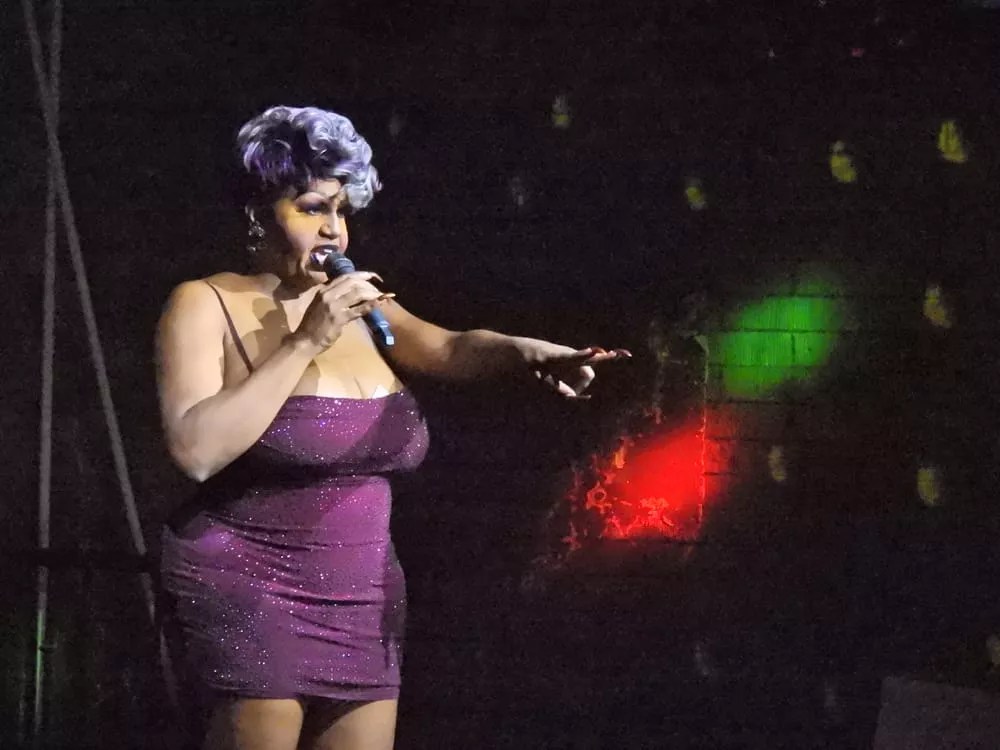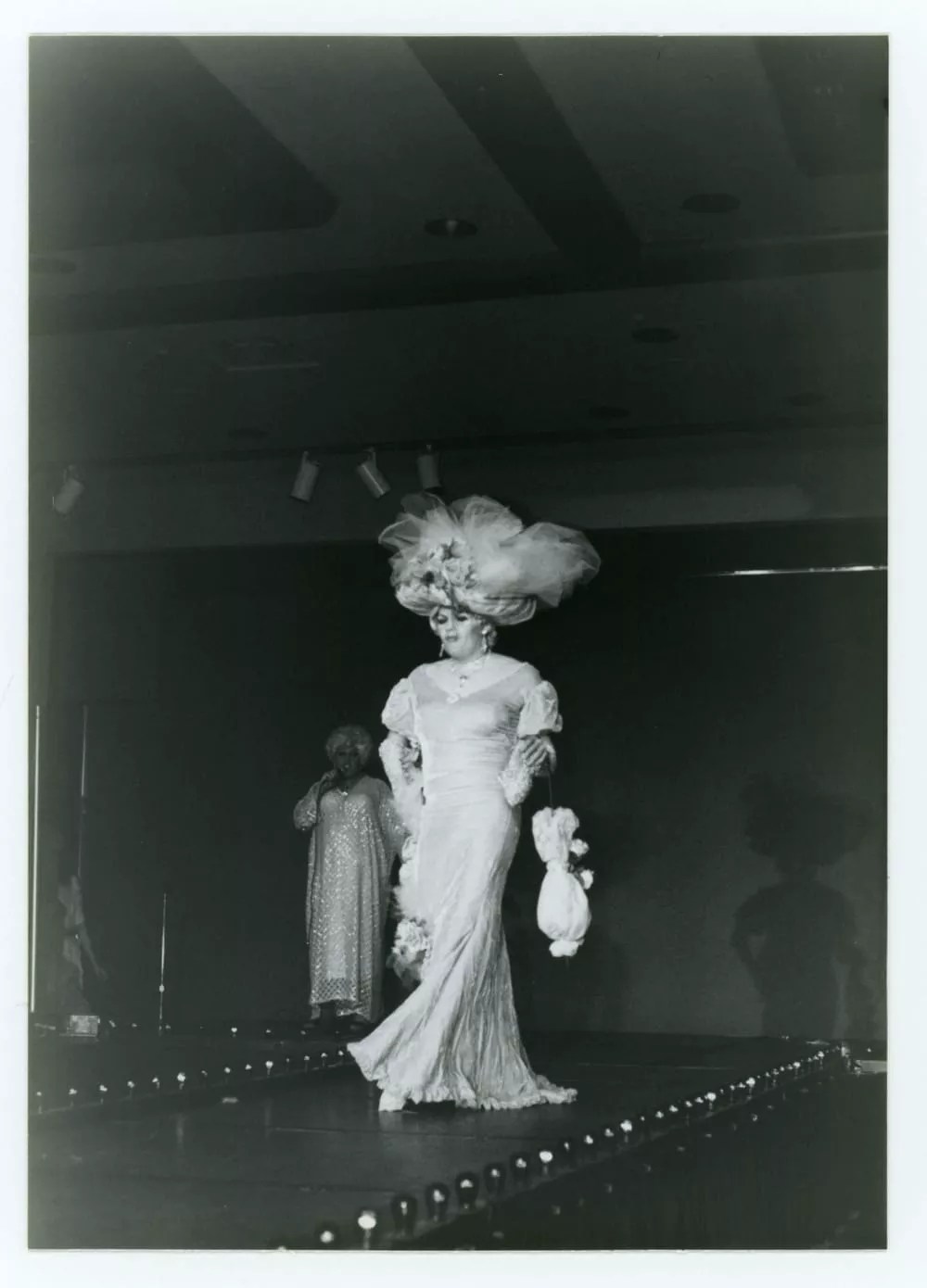
Courtesy of BJ Bud Archives

Audio By Carbonatix
This story was first published by LOOKOUT, an investigative nonprofit news organization covering Arizona’s LGBTQ+ communities.
We will never hear the song Freddie Mercury would sing in his 60s, watch the film Rock Hudson would star in his 70s or see the painting Keith Haring would produce in his 50s. In the minds of the ones they left behind and the generations that followed, they remain forever young, frozen in amber.
In Arizona, though, there are a number of elders within the drag community who many look to for guidance. But as drag has become more visible and accepted into the mainstream, it’s come with heavy baggage, specifically since far-right and religious voices – from the state Capitol to local school boards – have shown up with guns, bomb threats and false accusations of child sexual assault.
The one-two punch of love and hate is familiar to Mia Inez Adams, 66, an elder in the Phoenix drag scene who spoke to LOOKOUT. She said there’s been an evolution of drag locally, but there are still unique challenges older performers experience.
“There were times you could be on the marquee on a Friday or a Saturday, and then on a Sunday, that exact same bar didn’t want you in the building because you were a drag queen,” says Adams, who got her start performing over four decades ago in Florida. “There was a kind of shame associated with being a drag performer.”
With shows like “RuPaul’s Drag Race” attracting larger, more mainstream audiences, drag – the uniquely queer and gender-bending art form – has shaken much of its stigma and attracted a whole new wave of participants who are pushing the boundaries of the art form.
“You have cisgender women doing drag, you have cisgender women performing as drag kings, you have cisgender drag performers performing as no gender,” says Adams, who serves as a host of a local amateur talent competition “Rising Star” at the Phoenix gay bar Stacy’s @ Melrose. “I have a person that is a dragon, a literal dragon. They’re not a he, not a she, they’re a dragon. That’s how they perform, as a dragon.”

Mia Inez Adams performs at Stacy’s @ Melrose.
Courtesy of LOOKOUT
The increased interest in drag has made competition for stage time even more competitive, according to Adams.
When she first started performing, drag queens honed their craft on stage, performing at every talent competition and pageant they could find, Adams says.
That’s unusual for performers today. Many aspiring drag queens learn the basics of wigs, makeup and stagecraft on YouTube and build audiences on social media before ever venturing into public.
Adams says it’s a double-edged sword.
“If you were performing and you did a cartwheel and your boobs fell off or your hair fell out, only those who were there saw it,” she says, describing the freedom drag queens had to experiment and make mistakes before the days of social media. “Nowadays those kinds of instances have torn many a drag person down because they’ve turned it into a meme, or it’s become a GIF.”
Adams spoke from experience. Recently, some particularly graphic footage of her performing with a gogo dancer made its rounds on the internet. Adams insisted the footage was a deep fake, but she enjoyed the online chatter.
“Until you can laugh at yourself, you shouldn’t have any business laughing at anybody else,” says Adams, who is the matriarch of the Adams family, a loose network of over 100 drag queens from around the world, including bold-faced names within the drag community like Kizha Carr Adams, Rosé and Jasmine Rice Lebeija.
Her advice to her drag babies and grandbabies is simple: Don’t rest on your laurels.
“If you come out and you think you’re just going to be a look queen, well, at some point we’ve seen all your looks,” she says. “So learn to be a look queen, a comedy queen, a dancing queen, an acting queen. Learn to be as many different types or versions of yourself as possible so that you’ll always remain relevant.”

Phoenix drag queen royalty Barbara Seville emceed Dragstravaganza at Phoenix Fan Fusion 2023 while wearing a shiny, purple Batman costume.
O’Hara Shipe
Richard Stevens, 50, who performs as Barbra Seville, also enjoys mentoring the next generation of performers, pushing new drag queens to think outside the box and take more risks.
He says when he runs shows, he knows exactly what the performances will be: “I know two people want to do Rihanna, two people want to do Dua Lipa and they’re all going to wear an outfit that looks like the other one. I don’t always see the spark of inventiveness or the spark of curiosity or the spark of individuality that I would love to see.”
Following in a long line of drag queens advocating for the LGBTQ+ community, Stevens made headlines when he called out Republican senatorial candidate Kari Lake after she criticized drag queens, revealing that she was once a friend and had attended many of his drag performances. Lake lost her battle for governor that same year.
“Before the Kari Lake thing, I would say I was probably more fearless as Barbra Seville,” he says. “But I handled almost all of the Kari Lake stuff out of drag and it showed me that I’m just as smart, competent, informed and well-spoken.”

A vintage photo of a Phoenix drag performance.
Courtesy of BJ Bud Archives
For Regina Gazelle, 66, activism and drag have always gone hand in hand. She came out in the wake of the Stonewall riots and was active in the Gay Liberation Movement in Los Angeles.
“Having a microphone in your hand is a very powerful, powerful position,” she says. “And if you get that power and you know how to use it well, you can go a long way.”
When she first got her start doing drag at 16, drag performances were difficult to find, and “pantomiming” or lip-syncing as it’s referred to today, was relatively rare. For the most part, drag queens were expected to sing and embody a specific starlet, she says.
“Usually it was just basic,” says Gazelle, who leads a TGirl (short for transgender girl) Revue that travels the state. “You get into drag, you try to look like a particular entertainer that you were doing and you were known for that. You were a Diana Ross, you were a Tina Turner, you were a Carol Channing entertainer.”
Gazelle says she’s proud of how much drag has evolved and how far the LGBTQ+ community has come, and remembered when solidarity among LGBTQ+ people was scarce.
“It will always be a competitive lifestyle,” she says. “But we’ve become more loving to one another, more supportive to one another.”